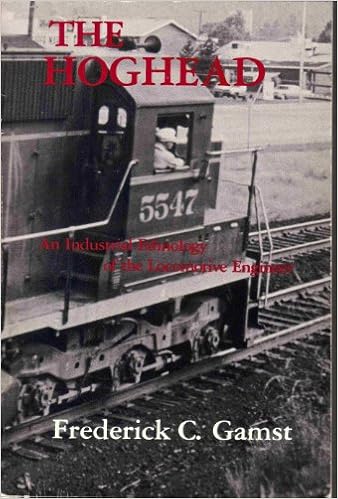
Hoghead: Industrial Ethnology Of The Locomotive Engineer (Case Study In Cultural Anthropology) Download Free (EPUB, PDF)

Series: Case Study in Cultural Anthropology
Paperback: 160 pages
Publisher: Holt McDougal; First Edition edition (March 1980)
Language: English
ISBN-10: 0030526361
ISBN-13: 978-0030526367
Product Dimensions: 8.4 x 5.8 x 0.7 inches
Shipping Weight: 1.1 pounds
Average Customer Review: 5.0 out of 5 stars See all reviews (2 customer reviews)
Best Sellers Rank: #2,198,131 in Books (See Top 100 in Books) #84 in Books > Business & Money > Job Hunting & Careers > Job Markets & Advice #2293 in Books > Business & Money > Economics > Labor & Industrial Relations #144897 in Books > Politics & Social Sciences > Social Sciences

This is as far as I know, the ONLY serious study concerning what railroad work entails and how railroaders become enculturated into their crafts. It is written specifically from the perspective of the Locomotive Engineer (Engine Driver, for those of you living outside the USA). Author Frederick Gamst writes in his preface that he conducted his research between 1955 and 1961, during 6 1/2 years employment in engine service, as well as fieldwork between 1970 and 1975.Gamst refers to the individuals, unions, and companies by fictitions names in this book to protect privacy, also undoubtedly not to discourage participation in the future. The railroad he worked for and later further researched is fictitiously called the "Central City and Urbana Railroad". According to other works by Gamst I have read, it appears to have been the Western Division of the Southern Pacific.For those with no experience whatsoever in Anthropology or Sociology, don't despair! Dr. Gamst explains the importance and meaning of industrial ethnology as well as he explains railroad terms, customs, and behaviors. Chapters include:1. Introduction (Scope of the Book, In the Rail World, Industrial Ethnology)2. The Railroad and its Setting (Development of the railroads and the United States, Railroads in Contemporary American Society, The Geographical Setting of the CC & U)3. Hiring Out (Enculturating the Railroader, Becoming a Student, Examining the Diesel-Electric, Learning the Craft, Flattening Wheels, Learning, A Retrospection)4. Operating and Other Rules (The Book of Rules, Scope of Rules, Local Additions to Rules, Rules as Ideal and Actual Patterns, Examinations on Rules, Rules, a Retrospection5.
Hoghead: Industrial Ethnology of the Locomotive Engineer (Case Study in Cultural Anthropology) Steam Locomotive Driver's Manual: The step-by-step guide to preparing, firing and driving a steam locomotive The Social Life of Things: Commodities in Cultural Perspective (Cambridge Studies in Social and Cultural Anthropology) Cultural Anthropology: Appreciating Cultural Diversity The Dobe Ju/'Hoansi (Case Studies in Cultural Anthropology) The Industrial Design Reference & Specification Book: Everything Industrial Designers Need to Know Every Day The Art of the Locomotive Locomotive (Caldecott Medal Book) Santa Fe Locomotive Development: A Pictorial History in Chronological Order Steam to Diesel 1869 - 1957 Scooby-Doo Set of 8 Mystery Chapter Books (Haunted Castle ~ Snow Monster ~ Fairground Phantom ~ Spooky Strikeout ~ Case of the Haunted Hound ~ Case of the Living Doll ~ Case of the Spinning Spider ~ The Creepy Camp) Conformity and Conflict: Readings in Cultural Anthropology (15th Edition) Essentials of Cultural Anthropology: A Toolkit for a Global Age Cultural Anthropology: Asking Questions About Humanity Cultural Anthropology (3rd Edition) Cengage Advantage Books: Culture Counts: A Concise Introduction to Cultural Anthropology Mirror for Humanity: A Concise Introduction to Cultural Anthropology Cultural Anthropology: A Toolkit for a Global Age Social and Cultural Anthropology: A Very Short Introduction Cengage Advantage Books: Cultural Anthropology: A Problem-Based Approach Cultural Anthropology: The Human Challenge



